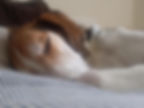Why The “Nothing In Life Is Free” Protocol Has No Place In Modern Day Dog Training.
- Emily Savage
- Apr 7, 2022
- 7 min read
Updated: May 12, 2022
In my recent blog entitled “Are We Failing Our Fearful Dogs In How We Feed Them,” I wrote about a Facebook campaign from a well-known public figure, which encourages people to make the following pledge:
“I promise to use my dog’s food in training and if I am unable to feed my dog all of their food during active training, I will put whatever is left over into hollow chew toys to help my dog learn to love settling down quietly with their chew toy.”
The free course videos which accompany this campaign clearly state, "make them earn it," and ask that we pour all daily food rations into a jar, only feeding when our dogs are not "misbehaving."
If you missed this blog, you can read it here: https://www.trailiepawsforthought.com/post/are-we-failing-our-fearful-dogs-in-how-we-feed-them
You will see that I draw a parallel with the “Nothing In Life Is Free” protocol, where a dog displaying undesirable behaviours receives nothing freely, whether that is meals, treats, attention, petting, play, playmates, toys, access to outdoor environments, comfy resting areas, and so on. The comparison I made prompted some conversation, during which it was argued that the NILIF protocol can be implemented as part of a force-free approach to dog training. Having seen first hand the emotional and psychological harm this can cause, I am going to put forward why I believe there is no place for NILIF in this day and age, and why it deserves to be banished to the dark ages of dog training.

What Does NILIF Promote?
Here are some statements taken from the following document which outlines how and why to implement NILIF: Microsoft Word - NILIFCampCanine.doc (campcaninect.com)
“N.I.L.I.F stands for ‘Nothing in life is free’. This means exactly what it says. As humans, we have to work for what we want and so should our four legged companions.”
“N.I.L.I.F………. creates a hierarchy within the house-hold and helps to assign the dog its place in the family. It helps to maintain order, and reduces conflict, and promotes cooperation among pack members.”
“Eventually, the dog will realize that it must obey your command to get what it wants.”
“ ‘Nothing in life is free’ communicates to the dog that the human is the top dog in its pack and that the human is in control.”
“Not all but some dogs may challenge their owners for dominance.”
“……… children (aged eight and over) should also learn and practice ‘nothing in life is free’ with the dog. So they too, are seen higher in the hierarchy chain over the dog.”
How This Fails Us and Our Dogs
When following the NILIF protocol, the human controls all resources, and the dog, to the nth degree. This is based on the outdated and debunked dominance theory, rank reduction, pack leader way of thinking, which should have died a death a long time ago. Sadly, because of a lack of regulation in the dog training industry, it continues to be perpetuated. It has led to an increase in using punishment to make corrections, a prime example being the ‘alpha roll’ where the dog is physically forced into submission because the human believes that he needs to “be the boss”. Forcefully manipulating your dog in this way will frighten him, and the only lesson he will learn is to fear you.

Attempting to dominate your dog in this way is extremely harmful, despite the huge number of sources out there which still teach this, ranging from websites, books, trainers on television, to your next-door neighbour. The belief that dogs live within hierarchies with a top dog dominating the others has been thoroughly debunked, yet still this myth rages on. The use of the word “command” is also very significant, a term which has been amended to “cue” in force-free circles. Commanding your dog to do something doesn’t reflect that he is a sentient being who feels, thinks and learns; more to the point, he learns that he has no choice but to obey. Children who bear witness to this will also believe that this is how dogs should be raised and treated, which means that this outdated school of thought will most likely continue to be perpetuated indefinitely.
Aside from this approach causing harm to both the dog and our relationship with them, a side effect of this micro-management is the lack of opportunity and freedom for the dog to make choices. The importance of agency is well-documented; it helps to promote good mental health, it builds confidence and resilience, and it allows the dog to keep themselves feeling safe. This freedom of choice should extend to anything we do with them, for example, when carrying out husbandry tasks. Cooperative care allows our dogs to be listened to so that we work at their pace, acknowledging their signs of consent, and discontinuing what we are doing if they indicate they are feeling uncomfortable. They deserve to be listened to, with their choices being respected.
The Five Freedoms
This need for the dog to earn absolutely everything has serious implications when aspiring to meet the Five Freedoms, which state that an animal should have:
Freedom from hunger.
Freedom from discomfort.
Freedom from pain, injury, or disease.
Freedom to express normal behaviour.
Freedom from fear or distress.
If a dog is expected to work for all of his food, it’s unlikely that he will ever feel truly satiated. Being drip-fed his meals throughout the day will mean that he won’t experience that post-dinner contentment, or enjoy food enrichment activities which are hugely beneficial for the dog, but not so much for the human. As discussed in my previous blog, the potential for increasing stress and anxiety for our dogs through using food aversively is a real risk, therefore will have a knock-on effect for all the five freedoms. If we cannot allow our dogs to enjoy their meals in peace, where they feel safe, in the way that they enjoy them, we cannot shield them from the discomfort of hunger; this may lead to a lack of proper nourishment, which is detrimental to both the mind and body.
The control of food is only a small part of NILIF; it also extends to the most basic of needs, such as bedding, a comfortable place to rest, and the choice of where they feel safe enough to sleep.

With the lack of freedom of choice and having to earn access to resources such as toys, play, and attention, this leaves no room for the expression of normal doggie behaviours. How can we possibly provide our dogs with the best possible care, catering to both their mental and physical needs, if we restrict them in such a way that they can do nothing without instruction and have to earn everything they have, including their most basic rights? Where does learning fit in, and providing them with enjoyable mental and physical stimulation? How do we cater to their emotional needs, if all we focus on is observable behaviour?
One could argue that NILIF is founded on positive reinforcement because, after all, behaviours are being rewarded. However, controlling all resources in this way, where the dog has to do what we ask of him in order to gain access to what he wants and needs, surely that is coercion? How do we maintain their well-being, meeting both their physical and psychological needs, while nurturing their individuality and developing our bond with them? Something to think about.
There are some disturbing cases where NILIF has been carried out to extremes. In Kathy Sdao’s book, “Plenty In Life Is Free”, she talks of a dolphin trainer who actually used air as a reward, and a dog handler who included access to water as a resource to be earned for a guide dog in training. These are both shocking cases in the extreme, and one has to question how the NILIF approach can be regulated in order to avoid such cases. Many people take advice literally, so how can we ensure dogs will not be denied their basic rights to survive, let alone meet all of their needs? How can this possibly sit within a do-no-harm, force-free approach?
As a fearful dog guardian, I feel my primary task is to keep my dogs feeling safe by minimising stressors as much as I can, and helping them to feel better about the ones that can’t be avoided. Classical conditioning plays a large part in the training that I do with my fearful dog, more so than teaching behaviours. Because of the strict Skinnerian approach of NILIF, where behaviours must be performed for positive reinforcement, the counter-conditioning and systematic desensitisation, which has made such a tremendous difference to my fearful boy's confidence and resilience, would not come into play at all because asking for behaviours does not feature in classical counterconditioning. His physical and emotional welfare is my priority and, while I’m sure it’s great to have a dog which is considered “well-behaved”, his health and happiness during his all-too-short existence is so much more important.
In conclusion, the "Nothing In Life Is Free" protocol is incompatible with force-free training because implementing it prevents the upholding of the five freedoms and maintaining good welfare standards. It goes against everything we have learned and how we have come to view dogs, thanks to the science we have access to, and pioneers in force-free handling and training methods. Thankfully, in recent years, there has been a definite shift towards a more dog-centred approach to training, where the dog’s emotional needs are considered foremost. A change of language from “ownership” to “guardianship” reflects this change in thinking, and it is a most welcome one. Emphasis is placed on observation, communication, companionship and partnership, instead of control and obedience through micro-management of behaviours. Having the freedom to express themselves and make choices builds confidence, individuality, and well-rounded, happy, and healthy hounds.

If you have found this useful, why not subscribe to receive my future blog posts? Don’t forget to check your junk mail folder, just in case! You can also find my blogs, along with other science-based, dog-centred posts and articles over on my Facebook page: Trailie Paws For Thought | Facebook
.